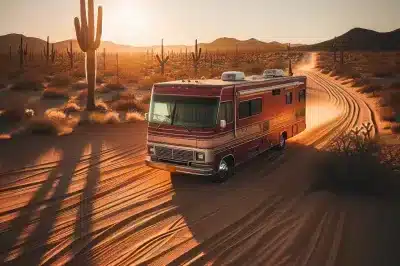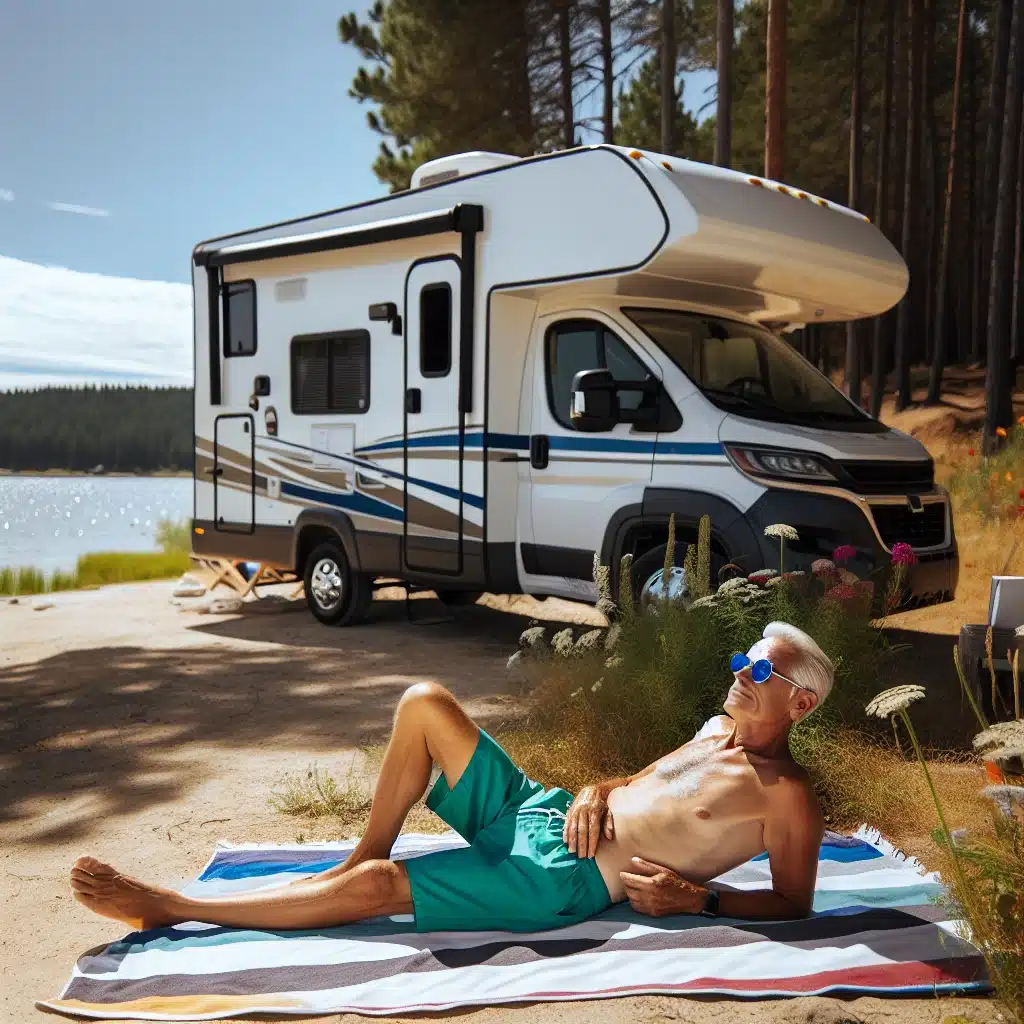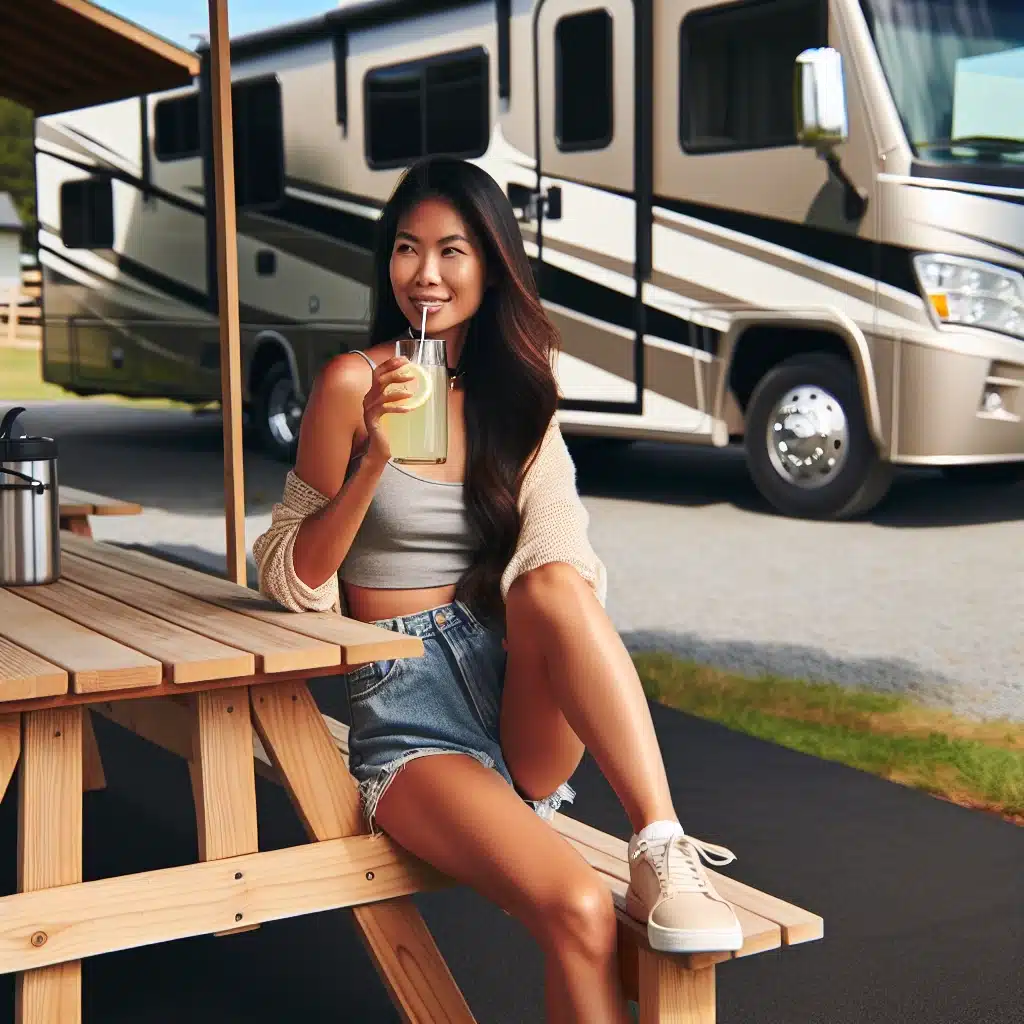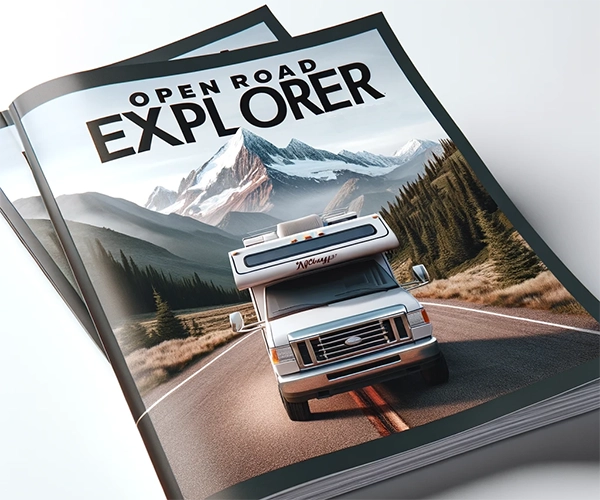Table of Contents

Article-at-a-Glance: Harnessing the Sun for Ultimate RV Freedom
- Discover how solar power can revolutionize your RV boondocking experience.
- Learn to select the best solar panels tailored to your RV’s energy needs.
- Understand the importance of charge controllers in protecting your power supply.
- Explore battery options to ensure you have power even when the sun sets.
- Find out how power inverters can help you use your appliances just like at home.
The Solar Setup: Powering Your Off-Grid Adventure
Imagine waking up to the gentle hum of nature, your RV cozily tucked away in a scenic spot, far from the nearest plug-in power source. This dream is possible with solar power – your ticket to freedom and sustainability on the open road. A well-thought-out solar setup not only provides clean energy but also ensures that you stay powered up without a hitch. Let’s get you started on how to create an efficient solar power system for your RV, ensuring you can enjoy the wilderness without sacrificing comfort.
Choosing the Right Solar Panels for Your RV
When it comes to solar panels, one size does not fit all. Your RV’s roof space, energy requirements, and travel habits dictate the type of solar panel that will serve you best. Monocrystalline panels are efficient and space-saving, ideal for smaller roofs or higher power needs. Polycrystalline panels, on the other hand, are cost-effective and work well for those with more space. Thin-film panels are lightweight and flexible, perfect for unconventional roof shapes. It’s crucial to calculate your energy usage to determine the wattage and number of panels you’ll need.
Charge Controllers: Guarding Your Energy Supply
Think of a charge controller as the gatekeeper of your solar power system. It regulates the voltage and current coming from the solar panels to the batteries, ensuring they don’t overcharge and have a longer life. There are two main types: PWM (Pulse Width Modulation) and MPPT (Maximum Power Point Tracking). While PWM is more cost-effective, MPPT controllers are more efficient, especially in varied weather conditions. It’s essential to match the controller with your solar panel setup for optimal performance.
Batteries: Storing Sunshine for a Rainy Day
Your adventure shouldn’t end when the sun goes down. Batteries store the solar power collected during the day for use at night or on cloudy days. Deep-cycle batteries, specifically designed for RVs, are robust and can handle repeated discharging and charging. There are several types to choose from: lead-acid, AGM (Absorbent Glass Mat), and lithium-ion. Lithium-ion batteries, although pricier, are lighter, have a longer lifespan, and offer a higher depth of discharge. The capacity you need depends on your power usage, so tally up those energy needs before making a decision.
Power Inverters: Converting Sunbeams to Usable AC Power
Solar panels and batteries deal with DC (direct current), but your RV appliances need AC (alternating current). Enter the power inverter. This device converts DC power stored in your batteries into AC power that can run everything from your laptop to your coffee maker. Inverters come in different sizes and types, such as modified sine wave and pure sine wave. Pure sine wave inverters mimic the power you get at home, ensuring your electronics run smoothly and efficiently. Choosing the right inverter is critical – it should match the total wattage of all the appliances you plan to use simultaneously.

Eco-Conscious Comfort: Ensuring Your RV’s Energy Efficiency
Going solar is just the start. To truly embrace the boondocking lifestyle, you need to make sure every aspect of your RV is working as efficiently as possible. It’s not just about generating power; it’s also about conserving it. By focusing on energy efficiency, you can extend the time you spend off-grid, reduce your carbon footprint, and save money in the long run. Let’s dive into some eco-friendly upgrades that can make a huge difference in your RV’s energy consumption.
LED Lighting: Brightening Your Space with Less Power
Lighting is a fundamental aspect of RV living, but traditional bulbs can be energy hogs. Switching to LED lights is a simple yet effective step toward energy efficiency. LEDs use a fraction of the power of incandescent bulbs and last much longer, so you won’t be changing bulbs frequently. They come in a variety of colors and brightness levels, allowing you to create the perfect ambiance without draining your batteries. Plus, they’re durable, which is ideal for the bumps and vibrations of the road.
Energy-Saving Appliances: Maximizing Efficiency
Your appliances are the heart of your RV’s home comforts, but they can also be the biggest drain on your power supply. When it’s time to upgrade or replace, look for energy-efficient models designed for RV use. These appliances are built to provide the amenities you need while using less energy. From refrigerators to air conditioners, opting for high-efficiency models can cut down your power usage significantly. Remember, the less power you use, the less you need to generate.
Pro Tip: When shopping for new appliances, always check for the Energy Star label – it’s your shortcut to finding products that are certified energy-efficient.
Smart Thermostats: Keeping Climate Control Efficient
Managing the temperature inside your RV is key to comfort, but it can also lead to excessive energy use. Smart thermostats are a game-changer for maintaining an efficient climate control system. These devices allow you to set schedules, adjust temperatures remotely, and even learn your habits to optimize heating and cooling. With a smart thermostat, you can ensure your RV is just the right temperature when you need it, without wasting energy when you don’t.
Water Wisdom: Managing Consumption While Dry Camping
Water is just as precious as power when you’re boondocking. Without a hookup, you’re reliant on what you bring with you, so every drop counts. Managing your water wisely ensures you can stay off-grid longer and avoid unnecessary trips to refill your tanks. Here are some strategies to help you conserve water, so you can enjoy the freedom of the wilderness for as long as possible.
Conservative Water Usage Tips and Tricks
Conserving water doesn’t mean sacrificing cleanliness or comfort; it’s about being smart with your resources. Simple changes in habits can make a significant impact. For example, turning off the tap while brushing your teeth or washing dishes can save gallons over time. Additionally, taking shorter showers or using a water-saving showerhead can drastically reduce your water usage. And when it comes to laundry, consider hand washing small items or using a compact, high-efficiency portable washer.
- Use a spray bottle for rinsing dishes to minimize water usage.
- Collect and reuse gray water for tasks like flushing the toilet or watering plants.
- Install low-flow faucets and showerheads to reduce water flow without compromising pressure.
- Opt for biodegradable soaps to ensure gray water can be safely reused.
- Monitor your water levels regularly to stay aware of your consumption.
- Consider using a solar shower bag for outdoor showers, saving your tank water for other uses.
Water Filtration Systems: Turning Nature into Necessity
When you’re miles away from the nearest water source, every drop counts. But what if I told you that the stream running by your campsite could provide all the water you need? With a reliable water filtration system, you can turn the abundant water sources found in nature into safe drinking water. These systems come in various forms, from simple pump filters to complex UV purifiers. Investing in a good water filtration system means you can extend your boondocking adventures without worrying about running out of water.

The Support Gear: What Else to Bring on Your Boondocking Journey
Your solar panels are installed, and your batteries are ready to go, but your preparation shouldn’t stop there. The right support gear can make all the difference in enjoying a hassle-free off-grid experience. From extra fuses to a comprehensive tool kit, it’s the little things that often save the day. Let’s talk about some of the essential items you should pack to ensure your solar-powered RV trip is as smooth as possible.
Portable Solar Generators: Backup Power When You Need It
Sometimes, even the best-laid plans can go awry, and the sun might not shine as expected. For those cloudy days, a portable solar generator can be a lifesaver. These compact powerhouses can be charged up on sunny days and then used to power your essential devices when your main system isn’t generating enough electricity. They’re quiet, emission-free, and an excellent backup for your energy needs. Make sure to choose one that suits the wattage requirements of your most crucial appliances.
Tools and Maintenance Supplies for Solar System Upkeep
Maintenance is key to ensuring your solar power system runs efficiently for years to come. A well-stocked tool kit should include a multimeter for electrical diagnostics, a set of wrenches for tightening connections, and a wire brush for cleaning terminals. Don’t forget spare parts like extra wiring, connectors, and fuses. Regularly check your system for any signs of wear and tear, and keep it clean from debris and dust. A little bit of upkeep goes a long way in keeping your solar setup in top condition.
Navigating the Wilderness: Staying Safe and Connected
Boondocking brings you closer to nature, but it also means being far from help if things go wrong. Staying safe is paramount, and that means being prepared for emergencies. A well-thought-out safety kit, knowledge of your surroundings, and a means to stay connected can all contribute to a secure and enjoyable adventure. Let’s explore the essentials for keeping safe and in touch, even when you’re off the beaten path.
Essential Safety Equipments for Solar-Powered Boondocking
Before you head out into the wilderness, make sure your RV is equipped with essential safety gear. A fire extinguisher, first-aid kit, and emergency flares should be within easy reach. It’s also wise to carry a snake bite kit and bear spray if you’re venturing into areas where wildlife encounters are possible. For those unforeseen mechanical issues, have an RV-specific roadside emergency kit on hand. And remember, the best safety tool is knowledge, so familiarize yourself with local hazards and emergency procedures.
Satellite Comm Devices: Keeping in Touch Off the Grid
When you’re nestled in the heart of nature, far from cell towers and WiFi signals, staying connected can seem like a challenge. But it’s not just about sharing your adventures on social media; it’s about safety and peace of mind. Satellite communication devices bridge the gap between remote locations and the outside world. These gadgets, ranging from personal locator beacons to satellite phones, ensure that you can reach emergency services or loved ones no matter where you are. Compact and easy to use, they’re an essential part of your safety kit.
Venturing with Confidence: Taking The Leap into Solar Boondocking
Taking the leap into solar boondocking can feel overwhelming, but with the right preparation, it’s an incredibly rewarding experience. It’s about more than just having the gear; it’s about understanding your needs, the limitations of solar power, and how to make the most of what you have. Knowledge is power, and the more you know about your solar setup and boondocking essentials, the more confident you’ll feel as you disconnect from the grid and reconnect with nature.
Common Mistakes to Avoid When Planning Your Solar System
Planning your solar system is exciting, but it’s easy to get caught up in the details and overlook the bigger picture. One common mistake is underestimating your energy needs, which can leave you without enough power when you need it most. Overloading your system with too many appliances can also lead to disappointment. Another pitfall is skimping on quality to save money upfront, which often leads to more expenses down the line. Lastly, improper installation can reduce the efficiency of your system, so it’s worth getting professional help or thoroughly researching DIY methods.
Checklist Before Hitting the Road: A Boondocking Prep Guide
Before you hit the road, a thorough checklist can ensure you’re fully prepared for your solar-powered boondocking adventure. Start by inspecting your solar power system: check the panels, batteries, charge controller, and inverter for any signs of damage or wear. Test all connections and ensure your batteries are fully charged. Pack your safety and emergency gear, including your satellite comm device, first-aid kit, and any region-specific items like bear spray. Double-check your water supplies and filtration system, and make sure you have a plan for conserving water.
- Inspect solar panels and clean any debris or dust.
- Test battery charge levels and connections.
- Ensure charge controller and inverter are functioning properly.
- Verify emergency gear is accessible and in good condition.
- Check water levels and functionality of filtration system.
- Review your route and identify potential water refill points.
- Prepare a list of local emergency contacts and familiarize yourself with the area.
Frequently Asked Questions (FAQ)
Do I need a generator if my RV is equipped with solar panels?
Whether you need a generator depends on your specific power needs and travel style. Solar panels can provide a significant amount of electricity, but they have their limits, especially during prolonged periods of cloudy weather or if you have high energy demands. A generator can serve as a backup power source, ensuring you have electricity no matter the weather. However, if you’re conservative with your energy use and have a well-sized solar setup, you may find that you rarely, if ever, need to use a generator.
How do I estimate how much solar power I will need for boondocking?
Estimating your solar power needs is like putting together a puzzle where your daily energy habits are the pieces. Start by listing all the electrical devices you’ll use and note their wattage. Next, consider how many hours you’ll use each device per day. Multiply the wattage by the hours of use, and you’ll have an estimate of your daily consumption. Remember to factor in the efficiency loss in converting solar power to usable electricity, which is typically around 10-20%. Add a buffer to your calculation to ensure you have enough power even on less sunny days.
– Make a list of all your electrical devices and their wattage.
– Calculate the daily usage in watt-hours for each device.
– Add up the total watt-hours to get your daily energy needs.
– Factor in efficiency losses and add a buffer for reliability.
– Consider seasonal changes in sunlight when planning your system size.
Can an RV solar power system run the air conditioner?
Running an air conditioner on solar power is a common question, and the answer is yes, but with caveats. Air conditioners consume a lot of power, so you’ll need a substantial solar array and battery bank to handle the load. It’s also about timing; using your air conditioner during peak sunlight hours when your panels are generating the most power is more feasible. For longer use, especially overnight, you’ll need to ensure your batteries can store enough energy. It’s often more practical to use other cooling methods, like fans or a swamp cooler, which are less power-intensive than traditional air conditioners.
How do I maintain my RV’s solar power system?
Maintenance is the key to longevity and efficiency for your solar power system. Keep your solar panels clean and free of debris to ensure maximum sunlight absorption. Check your battery connections for corrosion and tightness regularly. If you have lead-acid batteries, check the water levels and top them off with distilled water as needed. For all battery types, ensure they’re not being overcharged or discharged too deeply. Inspect your charge controller and inverter for any error messages or signs of wear. A little attention goes a long way in keeping your system at peak performance.
What are the best types of batteries for solar RV systems?
The heart of your solar system is the battery bank, and choosing the right type is crucial. Lead-acid batteries are the traditional choice, being cost-effective and widely available. AGM batteries, a type of lead-acid battery, are more durable and require less maintenance. However, lithium-ion batteries are becoming the preferred option for many RVers. They’re lighter, have a longer lifespan, and can be discharged more deeply without damage. While they come at a higher upfront cost, their performance and longevity can make them more cost-effective in the long run.
– Lead-acid batteries are affordable but require regular maintenance.
– AGM batteries are more robust and spill-proof, ideal for rugged travel.
– Lithium-ion batteries offer the best performance and lifespan but at a higher cost.
– Consider your budget, energy needs, and travel style when choosing batteries.
As you prepare to embark on your solar-powered boondocking journey, remember that the freedom it brings is matched by the responsibility of understanding and maintaining your system. The beauty of solar power is that it allows you to explore the untouched corners of the world while being kind to the environment.
With the right setup, maintenance, and a bit of sun, your RV can take you to places you’ve only dreamed of, without ever needing to plug in. So go ahead, harness the sun, and make memories under its warm glow, knowing that you’re powered by the cleanest energy around. Safe travels and sunny days to you, fellow boondocker!
- Boondocking RVs: Flexible Solar Solutions – 3 March 2024
- Renewable Energy Tips for Full-Time Boondocking RVers – 2 March 2024
- Boondocking Solar Power Systems: Sizing Options & Solutions for Motorhomes – 1 March 2024
